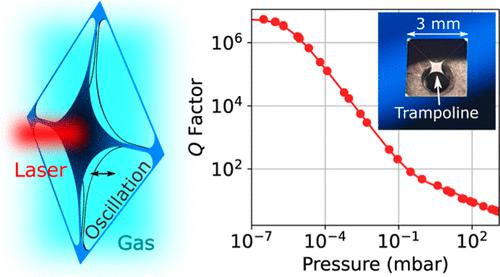当前位置:
X-MOL 学术
›
ACS Photonics
›
论文详情
Our official English website, www.x-mol.net, welcomes your feedback! (Note: you will need to create a separate account there.)
Self-Calibrating Gas Pressure Sensor with a 10-Decade Measurement Range
ACS Photonics ( IF 7 ) Pub Date : 2024-03-20 , DOI: 10.1021/acsphotonics.3c01488 Christoph Reinhardt 1 , Hossein Masalehdan 2 , Sandy Croatto 1 , Alexander Franke 2 , Moritz B. K. Kunze 1 , Jörn Schaffran 1 , Nils Sültmann 2 , Axel Lindner 1 , Roman Schnabel 2
ACS Photonics ( IF 7 ) Pub Date : 2024-03-20 , DOI: 10.1021/acsphotonics.3c01488 Christoph Reinhardt 1 , Hossein Masalehdan 2 , Sandy Croatto 1 , Alexander Franke 2 , Moritz B. K. Kunze 1 , Jörn Schaffran 1 , Nils Sültmann 2 , Axel Lindner 1 , Roman Schnabel 2
Affiliation

|
Recent years have seen a rapid reduction in the intrinsic loss of nanomechanical resonators (i.e., chip-scale mechanical oscillators). As a result, these devices become increasingly sensitive to the friction exerted by the smallest amounts of gas. Here, we present the pressure-dependency of a nanomechanical trampoline resonator’s quality factor Q over 10-decades, from 10–7 to 103 mbar. We find that the measured behavior is well-described by a model combining analytical and numerical components for molecular and viscous flow, respectively. This model relies exclusively on design and typical material parameters, together with measured values of intrinsic resonance frequency fin and quality factor Qin. Measuring fin and Qin at a pressure <10–7 mbar self-calibrate our sensor over its entire measurement range. For a trampoline’s fundamental out-of-plane vibrational mode, the resulting deviation between measured and simulated pressure dependencies of the quality factor and resonance frequency is within 15 and 4%, respectively. The resulting error for pressure values inferred from quality factor and frequency measurements is <10% for pressures between ∼10–6 and ∼10–1 mbar, and <25% for the complete 10-decade measurement range. Exceptions are two outliers with increased measurement errors, which might be related to the limited accuracy of our commercial pressure gauge. Based on investigations with helium, we demonstrate the potential for extending this sensing capability to other gases, thereby highlighting the practical use of our sensor.
中文翻译:

具有 10 个十年测量范围的自校准气压传感器
近年来,纳米机械谐振器(即芯片级机械振荡器)的固有损耗迅速减少。因此,这些设备对最少量气体产生的摩擦变得越来越敏感。在这里,我们展示了纳米机械蹦床谐振器的品质因数Q在 10 年来的压力依赖性,从 10 –7到 10 3 mbar。我们发现,测量的行为可以通过分别结合分子流和粘性流的解析分量和数值分量的模型来很好地描述。该模型完全依赖于设计和典型材料参数,以及固有谐振频率f in和品质因数Q in的测量值。在 <10 –7 mbar 的压力下测量f in和Q in可以在整个测量范围内对我们的传感器进行自校准。对于蹦床的基本面外振动模式,品质因数和共振频率的测量压力依赖性和模拟压力依赖性之间的偏差分别在 15% 和 4% 以内。对于 ∼10 –6和 ∼10 –1 mbar之间的压力,从品质因数和频率测量推断出的压力值的误差 <10% ,对于整个 10-decade 测量范围,误差 <25%。例外情况是两个异常值,测量误差增加,这可能与我们的商用压力表的精度有限有关。基于对氦气的研究,我们展示了将这种传感能力扩展到其他气体的潜力,从而突出了我们的传感器的实际用途。
更新日期:2024-03-20
中文翻译:

具有 10 个十年测量范围的自校准气压传感器
近年来,纳米机械谐振器(即芯片级机械振荡器)的固有损耗迅速减少。因此,这些设备对最少量气体产生的摩擦变得越来越敏感。在这里,我们展示了纳米机械蹦床谐振器的品质因数Q在 10 年来的压力依赖性,从 10 –7到 10 3 mbar。我们发现,测量的行为可以通过分别结合分子流和粘性流的解析分量和数值分量的模型来很好地描述。该模型完全依赖于设计和典型材料参数,以及固有谐振频率f in和品质因数Q in的测量值。在 <10 –7 mbar 的压力下测量f in和Q in可以在整个测量范围内对我们的传感器进行自校准。对于蹦床的基本面外振动模式,品质因数和共振频率的测量压力依赖性和模拟压力依赖性之间的偏差分别在 15% 和 4% 以内。对于 ∼10 –6和 ∼10 –1 mbar之间的压力,从品质因数和频率测量推断出的压力值的误差 <10% ,对于整个 10-decade 测量范围,误差 <25%。例外情况是两个异常值,测量误差增加,这可能与我们的商用压力表的精度有限有关。基于对氦气的研究,我们展示了将这种传感能力扩展到其他气体的潜力,从而突出了我们的传感器的实际用途。



























 京公网安备 11010802027423号
京公网安备 11010802027423号